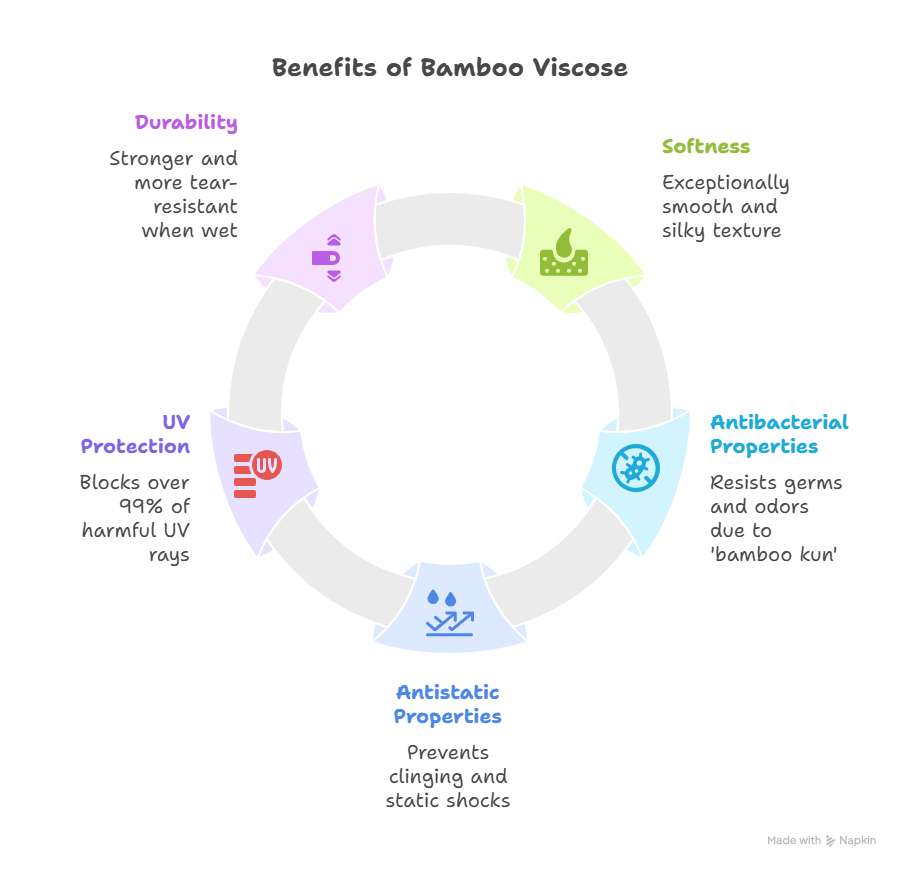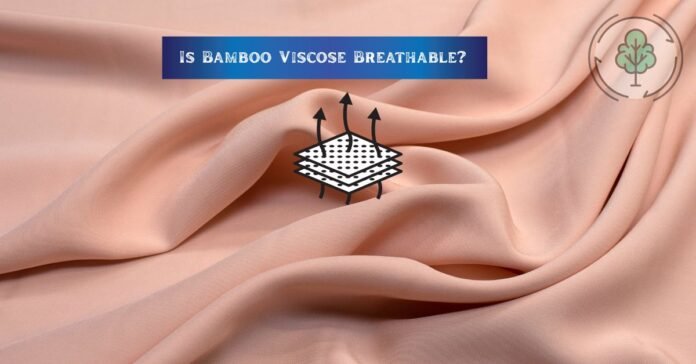Introduction-
The cellulose from bamboo stalks is processed to make viscose. It gives off a silky-soft texture which is loved for its eco-friendly clothing and bedding attributes. Furthermore, bamboo as a crop is appealing for fashion because it grows rapidly and does not need the use of pesticides. Because of these qualities, bamboo has become widely accepted in eco-friendly fashion circles. Bamboo viscose is often marketed as a green substitute to cotton, polyester, or other textiles. To increase comfort and strength, some brands blend it with silk or cotton which makes it easier to drape on soft summer dresses, loungewear, underwear, or even beddings. Regardless of all this information and advertising however, the general question shoppers have is: Is bamboo viscose breathable? This article answers that question along with examining the pros , cons and perfect uses of bamboo viscose.
What Is Bamboo Viscose?
Bamboo fibrous tissue is turned into viscose using bamboo processing methods. The bamboo stalks are broken down into smaller pieces, treated with dissolved caustic soda and carbon disulfide, then soaked in harsh solvents. After this, the sticks can be transformed into threads using special spinning designation machines. Bamboo lyocell uses an alternative method which puts back most of its used solvent instead of throwing it away.
Bamboo linen, or bamboo fiber, is made by literally smashing and separating the plant into strands which are then spun. This difficult process makes a stiff fabric similar to linen. All these fabrics share traits from bamboo but differ in eco-friendliness. Bamboo viscose is biodegradable in about a year, and bamboo plants regrow quickly. However, the way viscose is produced uses too many chemicals: about half of the poison used (caustic soda and carbon disulfide) goes to waste.
Is Bamboo Viscose Breathable?
No doubt, bamboo viscose lets air circulate very well. Its fibers soak up moisture and sweat while helping air flow through the fabric to keep skin cool. Many people say that the fabric made from bamboo is “cool to the touch” and breathable at the same time. For instance, one research showed that pure bamboo viscose gauze had much better moisture wicking and water vapor transmission compared to a cotton gauze of similar composition.
Also, bamboo viscose tends to have more give than cotton which may improve ventilation in garments. In practical terms, that means bamboo viscose far more quickly gets rid of sweat and permits circulation of refreshing air than stretchy fabrics do so, it keeps skin cool and dry. To sum it up, while many synthetic fabrics claim to be ‘breathable,’ this particular type of bamboo viscose outperforms them by a margin—and it also rivals cotton in how much air can pass through it or exceeds it greatly.
Why Is Bamboo Viscose Breathable?
Bamboo viscose is breathable for a number of reasons. To start with, its fibers contain numerous microscopic holes and capillaries which enable air to pass through. Put simply, air easily flows through the fabric carrying away heat from the body.
In addition, bamboo viscose has exceptional moisture-wicking properties: it absorbs sweat into the fiber where it can evaporate instead of sitting on skin. Indeed, high bamboo containing fabrics outperformed cotton in vapor transmission tests conducted earlier. Last but not least, bamboo viscose thermoregulates naturally: works to cool you down in hot conditions and offers mild insulation when temperatures drop.
Benefits of Bamboo Viscose Beyond Breathability
Bamboo viscose is also highly appealing because of the additional benefits that come with it;

- Users often refer to it as “buttery smooth” silk suggesting bamboo viscose is exceptionally soft and silky.
- In addition to this, bamboo viscose has antibacterial and hypoallergenic properties due to a substance found in bamboo called ‘bamboo kun’ which helps resist germs and odors.
- Also, clothes made from bamboo viscose do not cling to skin or produce static shocks due to its antistatic properties.
- Treated with these fabrics also protects the skin from harmful UV rays as bamboo fabric can block over 99% of UV rays.
- Lastly, bamboo fabrics are stronger and more durable than than suggested. Bamboo viscose fibers absorb more moisture than cotton, becoming even stronger when wet making it tear resistant and anti pilling.
Potential Drawbacks of Bamboo Viscose
Bamboo viscose, however, has its downsides.
Chemical Processing
Because it undergoes chemical processing, it doesn’t retain the same “natural” qualities as bamboo linen and loses some of the raw fiber’s character.
Extra Care and Maintenance
Like other rayon fabrics, bamboo viscose requires gentle handling due to its tendency to weaken when fully wet. It is also more likely than cotton to shrink or wrinkle if not properly cared for.
Production is not eco-Friendly
Most concerning, though, is the fact that viscose production has bad effects on environmental system, because bamboo viscose manufacturing relies on toxic chemicals: caustic soda and carbon disulfide both pose a significant risk.
No Recycling after Manufacturing
In fact, roughly half of these chemicals are not recycled after production, which poses a threat to water bodies if left untreated. Some factories have made changes in waste management during production; however, mechanically produced bamboo fabric remains far more eco-friendly than conventional bamboo viscose.
Best Uses for Bamboo Viscose
Because of bamboo viscose’s breathability, softness and moisture control it is ideal for many uses:

Clothing: Above all, during warm-weather months. Bamboo Viscose is well-suited for summer dresses, T-shirts, activewear and other light garments. It wicks sweat and lets air flow through the fabric so you are much cooler on hot days and activities.
Underwear & Socks: Because it feels soft against the skin bra’s and underwear along with socks make use of bamboo viscose’s antibacterial quality which helps socks stay fresh and wear odor free.
Bedding: Pillowcases, sheets, and blankets made from bamboo viscose are comfortable to wear and keep cool while sleeping making them vastly preferred for sleepers over cotton. Bamboo bedsheets have a unique silky smoothness that many users tout as ‘breathable and cool to the touch’.
Loungewear And Towels: The fabric’s plush, absorbent nature makes it perfect for loungewear and bathrobes as well as towels. They dry quickly feel so soft while still fighting odors due to its natural antibacterial properties.
Lightweight Apparel: Pajamas, scarves, or blouses become timeless due to their new softness from bamboo viscose which give them a frothy drape. Close-fitting garments made of bamboo are breathable thanks to its fibers allow airflow unlike most other fabrics.
How to Care for Bamboo Viscose to Maintain Breathability
Gentle care maintains the natural characteristics of the fabric. Here are tips to follow:
- Wash Gently: Wash with cold or lukewarm water (about 30°C) using a gentle cycle. Mild detergent washes well without harming fibers.
- Avoid Harsh Additives: Don’t add bleach or harsh fabric softeners. Bleach can soften and change color of fibers, whereas softeners deposit onto fibers, decreasing absorbency and air penetration.
- Drying: Air-dry flat or hang to dry. Dry with a dryer if necessary, on low heat. High heat will shrink or warp bamboo viscose. Take items out quickly and re-shape them.
- Ironing: Iron on low heat if necessary. Bamboo viscose can be steamed with a warm iron to get rid of wrinkles, but don’t use hot temperature in case it gets damaged.
- Additional Tips: Wash clothes inside-out to shield the surface. Wash bamboo products with the same colors on gentle cycles. These precautions keep the pores of the fabric open and allow airflow.
Conclusion-
To the question, “Is bamboo viscose breathable?” the answer is yes. Bamboo viscose is breathable because its porous cellulose fibers enable airflow and sweat to evaporate quickly. Its moisture-wicking properties are strong. Bamboo viscose has a soft and silky feel, naturally resists odors and UV rays, and has impressive durability.
Bamboo viscose works best for clothing that needs to be cooling and comfortable such as summertime apparel, activewear, undergarments, and even bedding. With gentle care, garments made from bamboo fabrics can last for many years. Nishabama eco scarf combines lahat’s breathibility with silk’s softness while being kinder to mother nature making it hypoallergenic fabric.
In conclusion bamboo fabric meets all expectations: it’s breathable; magically soft—hypoallergenic; gentler on our planet than most other materials. Saying this I can reaffirm if comfort AND breathability are two of your top concerns then you absolutely cannot go wrong choosing bamboo viscose. To put my final thoughts here saying every exotic promises that using herein real world works fantastically.
Read more >> Muslin fabric which is also breathable and best suited for summer clothing. Poplin fabric which is light weight and breathable as well is used in formal wears, shirts and dresses.
FAQs
Indeed, bamboo viscose is naturally hypoallergenic and gentle. Its antibacterial properties also help prevent irritating odors and bacteria. Many people with sensitive or allergy-prone skin find bamboo viscose soothing and irritation-free. In fact, bamboo viscose contains no harsh dyes or treatments, which is why even baby clothing is often made from this fabric.
Both bamboo viscose and cotton are natural materials that allow air to flow freely. As for moisture absorbency, both perform well but cotton performs the best out of the two. Bamboo is usually on par with cotton in wearing comfort but in hot and humid weather, bamboo outperforms it.
Yes, certainly. Bamboo viscose is superb in dealing with heat: it wicks away heat and moisture from the body, making cool air circulate around the body. This is why many bamboo clothing lines advertise their products for summer; the fabric truly keeps one comfortable in hot temperatures.
Actually, no – it helps with keeping you dry. Bamboo viscose wicks sweat away from your skin almost instantly so that it can evaporate. Tests have shown bamboo fabrics ventilate moisture better than many other materials, so you feel less sweaty in bamboo compared to non-breathable synthetics. In fact, many wearers report that bamboo fabric keeps them drier and cooler than other fabrics.

This was a helpful breakdown of bamboo viscose—especially the section on its breathability and how it compares to other fabrics. I hadn’t considered how the chemical processing affects its overall eco-friendliness despite bamboo’s reputation as a sustainable crop. It’s a good reminder that not all ‘green’ fabrics are created equal.
I didn’t realize that while bamboo as a crop is eco-friendly, the viscose made from it has such a chemically intensive process. That really highlights how sustainability isn’t always straightforward when it comes to fabrics.
I appreciate how this post breaks down both the pros and cons of bamboo viscose. It’s easy to assume anything labeled ‘bamboo’ is entirely eco-friendly, but the insight into chemical processing really helped clarify the full picture.